The F train’s Bay Parkway stop sits atop the densest cemetery in New York City. The headstones, like rows of crooked teeth, jut in all directions, and they sit so close to the cemetery’s outer boundary and nearby streets that, in 2010, a plowed pile of snow knocked over a few of the stones.
A closer look at Washington Cemetery reveals a color scheme. The headstones aren’t the jumble of grays and whites and blacks that one might expect to find at an old cemetery. They come, instead, in two varieties: weathered gray and jet black.
The jet black ones line the outer edges of the cemetery. They’re peculiar, adorned with photorealistic, laser-etched portraits of the deceased, and with text engraved in Cyrillic script. These are the headstones of Jewish immigrants from Russia and the former Soviet Union. As you walk inward, these black stones give way to light gray. And the Russian script disappears, replaced by epitaphs written in English and Hebrew. These belong to New York’s first wave of Jewish immigrants from Europe.
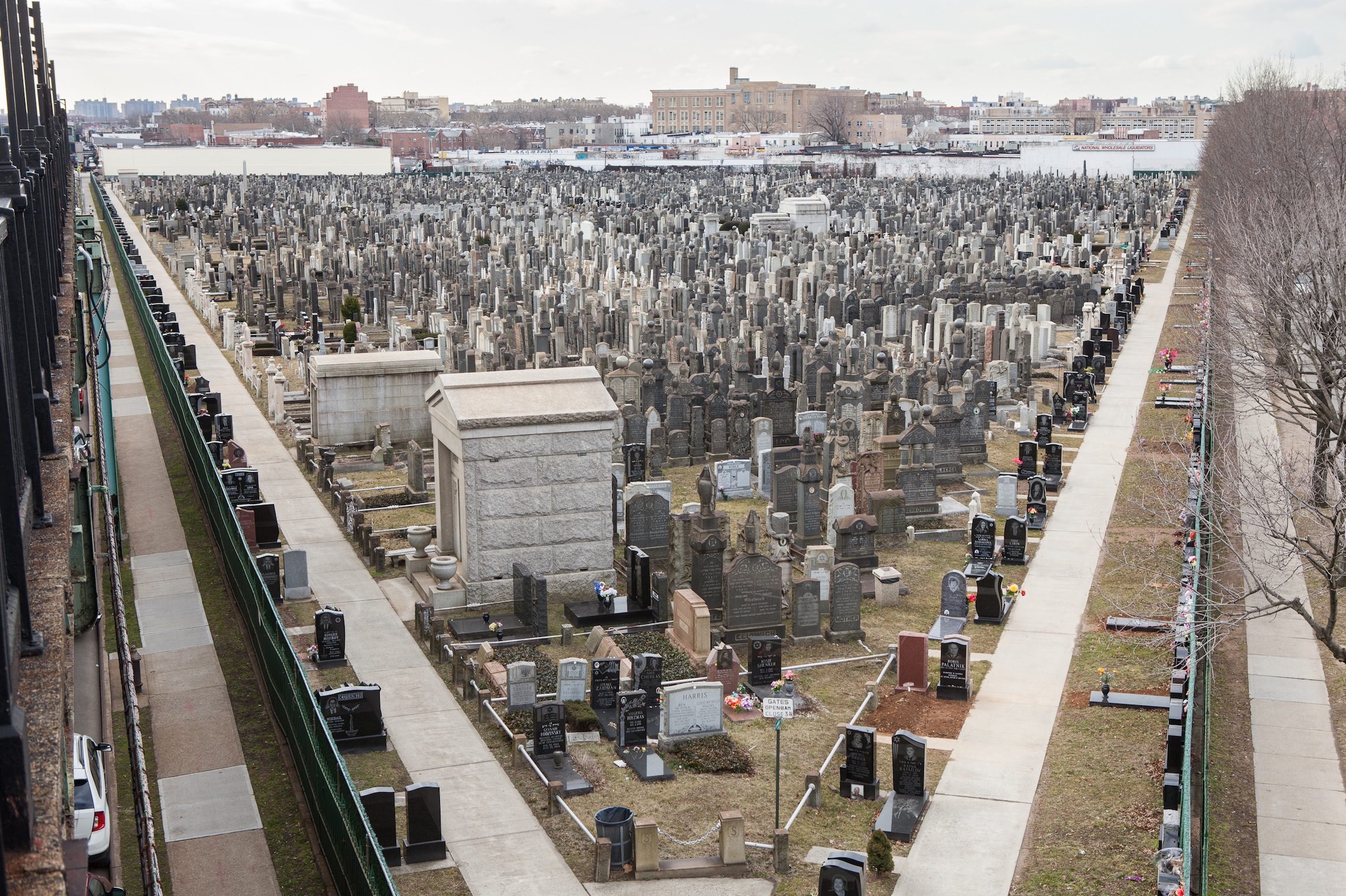
New York City cemeteries are a smorgasbord for history buffs: in a city this old, any given cemetery has a compelling narrative hidden among its stones. People love to visit old cemeteries. Green-Wood Cemetery even has a five-star rating on Yelp.
What makes Washington Cemetery visually interesting — what initially attracted me to it, and what probably attracted other recent media attention, too — is actually a symptom of its current problem: it’s full, and there are only a handful of graves left to sell. It is the first cemetery in New York City to pursue expansion since 1949, when the state started keeping cemetery records.
The genesis of Washington’s dilemma can be traced back a hundred years. Jewish immigrants in the late 1800s and early 1900s inadvertently tied up the cemetery’s plots for centuries, in an effort to provide for the poorest of immigrants. Several generations later, a small group of people discovered a way to exploit the system set up by the first-wave immigrants: selling their graves on a black market to a new wave of immigrants from Russia.
What happens when a Jewish burial ground in Brooklyn — one of the centers of American Jewish life — fills up?
In 1825, 36-year-old James Arlington Bennet bought 100 acres of land in New Utrecht, Long Island. Bennet had come to the United States fifteen years earlier. “He was always proud of the fact that there was only one ‘t’ in his name,” according to a remembrance in the Brooklyn Daily Eagle, “saying that all those with two of those consonants at the end of their name were Irish and informers.” (His own headstone at the cemetery spells his name with two.)
Some of that land was used as an unofficial cemetery for several years before Bennet officially established it as Washington Cemetery in 1853. He had bigger plans, though. Bennet was baptized into the Church of Jesus Christ of Latter-Day Saints in 1843 and, a year later, was chosen as the running mate for presidential candidate Joseph Smith, Jr., the founder of the church. (Smith was assassinated before Bennet could officially join him on the campaign trail.)
Bennet also fancied careers as an author, the governor of Illinois, and an inventor. When he invented a pair of wings, he sought an employee to demonstrate them. When no one volunteered, he took one of his farmhands, an Irishman, to the top of the cemetery office, where Bennet strapped the wings to the man’s shoulders. “Fly or die,” he said, pointing a musket to the man’s head. “Under such a condition of things the stranger thought it best to attempt to fly and he did so,” the Brooklyn Daily Eagle reported, “but unfortunately in doing so he broke his back.”
In 1857, six years before Bennet himself died, the cemetery was consecrated as a Jewish burial ground. The first Jew buried at Washington was the child of a man named Henry Cohen. Shortly after, the cemetery’s owners put an ad in the Brooklyn Daily Eagle: “Washington Cemetery.—The cheapest in the State.” For $3, one could purchase a single grave, and for $10, a 100-square-foot lot of ten graves. “We do not aim at the higher classes, but with such easy facilities to reach the cemetery, we receive a large patronage from the middle classes,” said the cemetery’s superintendent in 1877.
This strategy had a certain type of buyer in mind: around the same time, nearly three million Jews from Russia, Poland, and Austria-Hungary disembarked at Ellis Island, fleeing pogroms and persecution from all sides.
In practice, the America to which the European Jews fled was the Lower East Side. Severed from family and community ties in the old country, many joined societies called landsmanshaftn: groups of immigrants from a certain shtetl, or town, who pooled resources to provide emotional and financial support for their members. At one time, there were more than 20,000 active societies. The societies promised the familiarity of a landsman’s hometown language and faith, along with the financial support needed to sustain life in a new country. Dues-paying members, or landsleit, were given English lessons, life insurance, and other financial benefits that could get a poor immigrant through a tight spot.
The most important of these benefits, though, was a proper Jewish burial. Each society’s first act was to purchase a plot in a Jewish cemetery, often building a gate and border fence to distinguish it from other society plots. Some did this even before erecting a place of worship.
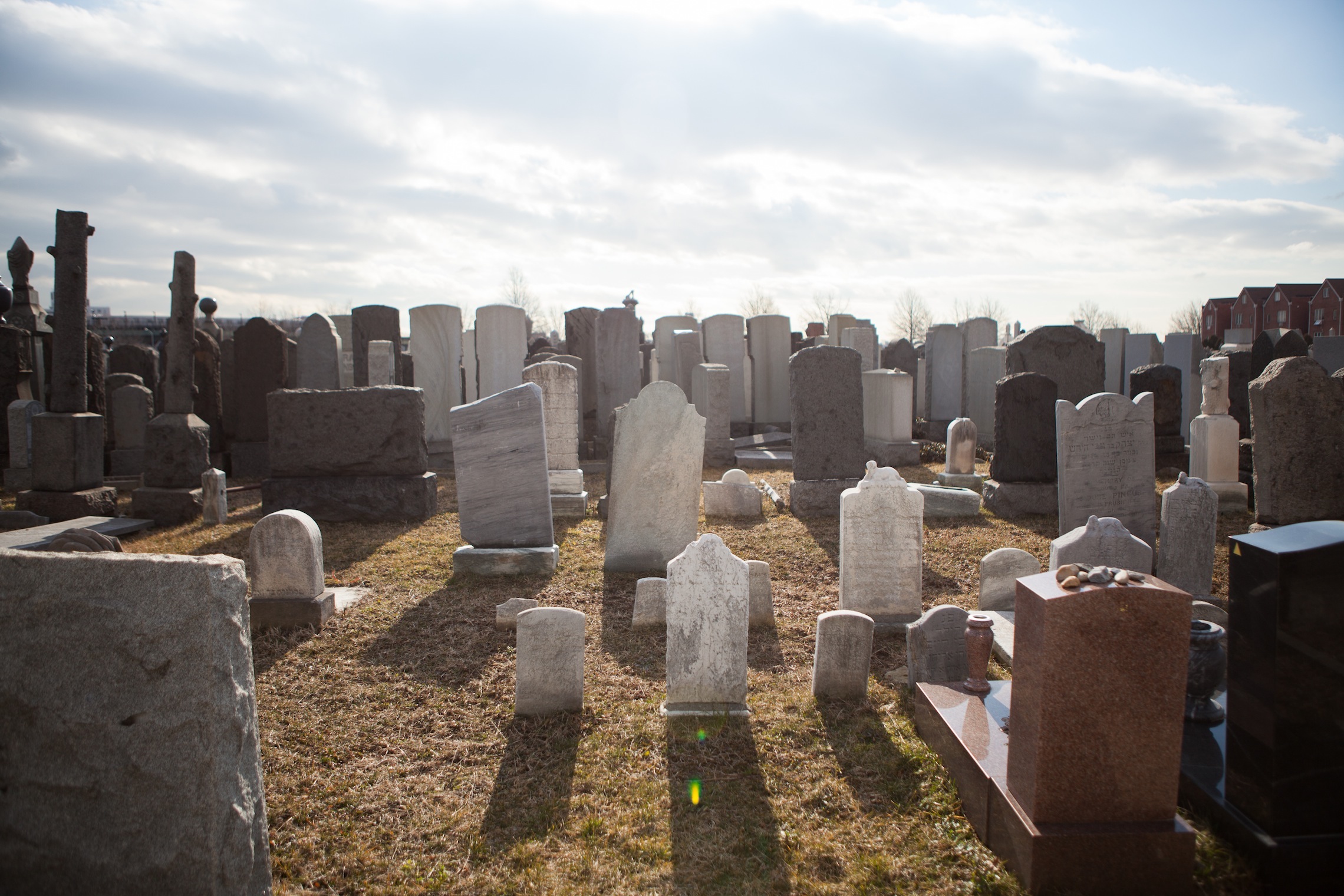
“A landsman died in the factory,” one elderly man said about the societies in 1938. “People think he is a Greek and bury him in potter’s field. Landsleit hear about it, his body is dug up, and the decision is taken to start our organization with a cemetery.”
At the same time, the construction of a new railroad boosted the appeal of Washington Cemetery’s inexpensive plots. In the late 1870s, the Prospect Park and Coney Island Railroad opened, taking passengers from downtown Brooklyn all the way to Coney Island and bisecting Washington Cemetery along the way. That railroad would later become part of the F line. By 1886, 35 acres of the cemetery were occupied by Jewish burial societies and congregations, leaving only 65 acres of available burial plots.
These were flush days. (At one point, a restaurant even operated within the cemetery grounds, until the Health Department shuttered it.) By the turn of the century, nearly 80 percent of the plots in the cemetery had been sold to societies. It needed to expand. So in 1897, its administrators proposed a 1,000-foot extension along Ocean Parkway, into what was then described as “woods.”
“The cemetery, which is for Jews, is fast filling up,” the Brooklyn Daily Eagle reported. Residents in the area, then known as Parkville, opposed the expansion. According to one nearby property owner, the cemetery’s expansion would “militate against the beauty of the boulevard, in the preservation of which cyclists and horsemen generally are interested.”
The city refused the proposal. More than 100 years later, it would do so again.
The cemetery’s superintendent’s office, in the rear extension of the main building, is a modest space with two resident parakeets named Tweet and Tweetie. Both were rescued from the cemetery grounds a few years back. In the past five years, the superintendent and general manager have also rescued kittens, tropical birds, guinea pigs, and — oddly — fish left in a tank on a grave.
Dominick Tarantino is the current superintendent. He is 76 years old and neither Russian nor Jewish but an Italian Catholic, born in Greenpoint. (“I think my doctor was Irish, because there’s no K in the Italian language,” he told me.) After 20 years in the concrete burial vault industry, he was hired at Washington in 1987 as a foreman and was later promoted to superintendent.
His only child, a daughter named Marisa, began working at the cemetery in 1991, when she was 24. It was supposed to be a temporary job in data entry. Now she serves as Washington’s general manager and main spokeswoman. Despite her soft spot for stray pets, she is brassy: dyed black hair, slate-green acrylic tips, a faint hint of gray lipliner, and 45 years of life in Brooklyn and Queens. Her “horrible, terrible” commute from Bayside runs about two hours on the Belt Parkway or the Brooklyn-Queens Expressway. Neither she nor Dominick thought twice about running a Jewish burial ground.
“It’s similar in the root of it all,” she said recently in Dominick’s office. “You know, the morals are the same. So it comes easy. If you have a lot of morals, you can deal with anything. And we have a lot of morals.”
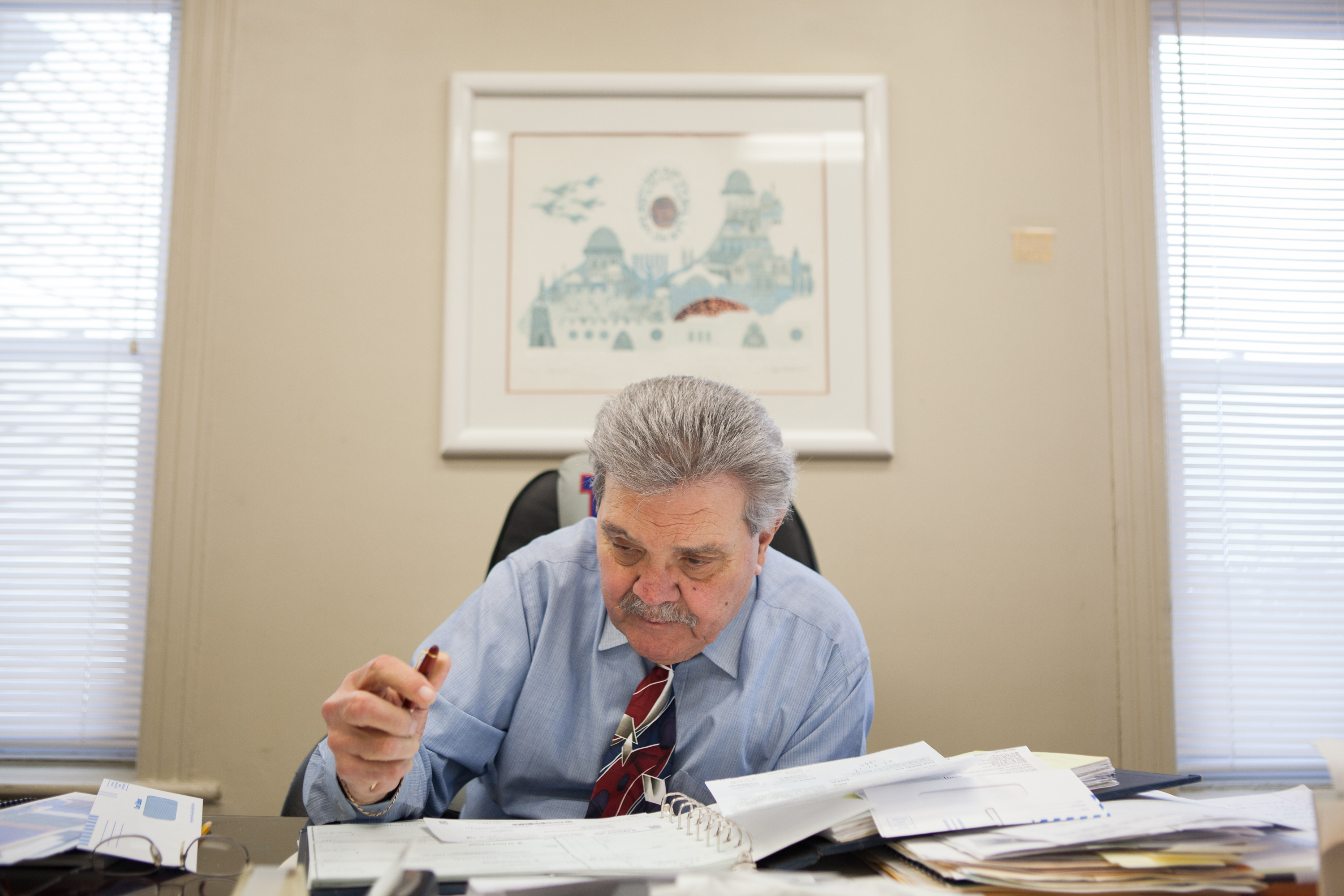
In recent years, a few unseemly incidents at the cemetery have been documented in tabloid headlines. In 2006, the cemetery’s 80-year-old caretaker at the time, James Scott, was arrested after a man allegedly found him urinating on his grandmother’s grave.
“I started to cry and scream, ‘Do you realize this is my grandmother’s grave?’” the man recounted to the New York Post. “I’m an old man — I can’t hold it,” the caretaker allegedly replied, eventually hitting the grandson on the head with a rake.
According to the grandson, the Tarantinos tried to bribe him with a key to the cemetery’s main building, which he refused. Marisa says that the whole situation was alleged, that the case later was thrown out of court, and that James Scott is no longer employed at the cemetery, as he was close to retirement anyway.
Around the same time, a woman visiting her father’s grave discovered that another person had been buried next to him, in the spot that her mother had purchased years earlier. The Post headline read, “What a R.I.P.-off!” The cemetery denied responsibility for the error, because the funeral home, I.J. Morris, controlled the burial plot. But the family sued the cemetery in addition to the funeral home and is still in litigation with them.
For a small Brooklyn business, any publicity — particularly from the Post or the Daily News — is typically bad publicity. The Tarantinos are, understandably, a bit skittish around reporters. They don’t have a website, a PR team, or a Twitter account. Washington’s image in the neighborhood is up to them.
When Dominick Tarantino first came to Washington Cemetery in 1987, the Russians were coming, too. On the same day Dominick was hired, the cemetery brought on a Russian-speaking office employee to take calls and translate.
Between 1975 and 1980, nearly 40,000 Soviet Jews arrived in Brighton Beach, famously establishing it as “Little Odessa” (or “Little Russia,” depending on whom you ask). That particular region of South Brooklyn — extending from Brighton Beach to Sheepshead Bay — lured immigrants with public housing, low- and middle-income co-ops, and synagogues. After the dissolution of the Soviet Union in 1991, that community grew even larger. Now, some estimate the Soviet émigré community constitutes 20 percent of New York’s Jewish population. And these émigrés are pretty much the only people Washington Cemetery currently buries. (The grounds are a ten-minute drive from Brighton Beach.)
While Russian Jews were flooding into Brooklyn, the children of the first wave of Jewish immigrants were heading out. Second-generation New York Jews began moving out of Brooklyn and into Long Island, New Jersey, and Florida. Fewer people made use of the burial society plots their families owned, which meant fewer traditional, gray headstones were going up in Washington Cemetery. The societies served less of a purpose, anyhow, now that second-generation New York Jews were largely assimilated and had fewer ties to the old country. Many society members preferred to purchase their own private plots in a different cemetery or near their new homes.
“We do have some born-here American Jews that we do deal with, but it’s not as many,” Marisa says. “We get a lot of calls from Florida, from people that have family members here.”
Richard Fishman, a 66-year-old man who calls himself a “regular American Jew,” is a member of a burial society. He moved to Brooklyn in 1978 and lived there until 2000. He has thought about his own burial someday, but not so much that he has concrete plans.
“I’m a member of a [burial] organization, so we have our graves,” he told me recently in his office. “Now, am I going to be using it? I don’t know. I’m going to retire soon. Am I going to stay here? Am I going to go to Florida? … I hate Florida.”
When they began to populate the cemetery, the Russian headstones — with their laser-etched portraits and fabric flowers left in piles besides them — caused controversy. Traditionally, American Jewish headstones are free of imagery, with pebbles left in lieu of flowers. Fishman, who is the director of the New York Department of State’s Division of Cemeteries, dealt with complaint calls.
“This Orthodox guy once called me up and said, ‘What is this, a botanical garden?”’ I said, ‘I saw pictures of Israel. They put flowers on the graves in Israel.’ He says, ‘That’s Israel, this is here. They’re not supposed to do that here.’”
The resistance to the new headstone style at Washington Cemetery reflected a broader phenomenon: a cultural rift between Russian-American Jews and descendants of first-wave American Jews, a conflict that has marked South Brooklyn for decades. In the sixties, American Jews marched for the liberation of Soviet Jews under the slogan “Let My People Go.” But once the Soviet Jews actually arrived, relations between the groups grew strained. In the Soviet Union, Jews had been barred from practicing their religion for decades, with Jewish identity taking on a more ethnic notion than a religious one. And when they arrived in Brooklyn, Soviet Jews confronted an intensely religious population.
“Here in South Brooklyn, you’ve got this unique situation,” says Leonard Petlakh, who was a teenager in the late 1980s when he left Minsk with his family and arrived in Sheepshead Bay. “You’ve got this radically secular Jewish community that came here. Radically secular. No religious tradition. And they came to the most Jewish area in this entire country. They’ve encountered a largely orthodox and increasingly ultra-Orthodox community. So, naturally, there’s very little common ground.”
Petlakh is now the executive director of the Kings Bay Y, a Jewish community center in Sheepshead Bay. A few years ago, he co-created a course at Hunter College on the history of Russian-Soviet Jewry. He’s since acted as an accidental spokesman for the community and now keeps a map of Brooklyn in his office for visitors who are uninitiated in South Brooklyn geography. (“The best investment I ever made,” he says.)
“Many Russians were placed in Orthodox Jewish day schools, and it was a miserable experience for a lot of them,” he says. “Many would say, ‘I went to yeshiva for a year but was kicked out after a year because I brought my bacon sandwich and the rabbi screamed at me.’”
Madeline Santella, the superintendent at Washington before Dominick, handled the first requests for the new headstone style, which she ultimately decided to honor. Doctrinal disputes aside, Santella’s decision was good for business. Washington Cemetery became the primary burial site for the Russian Jewish community in New York City.
“They visit a lot,” Marisa told me. “They’re big cemetery people, the Russian community, and that’s an important factor to them. People who’ve lost children can be here three times a week.”
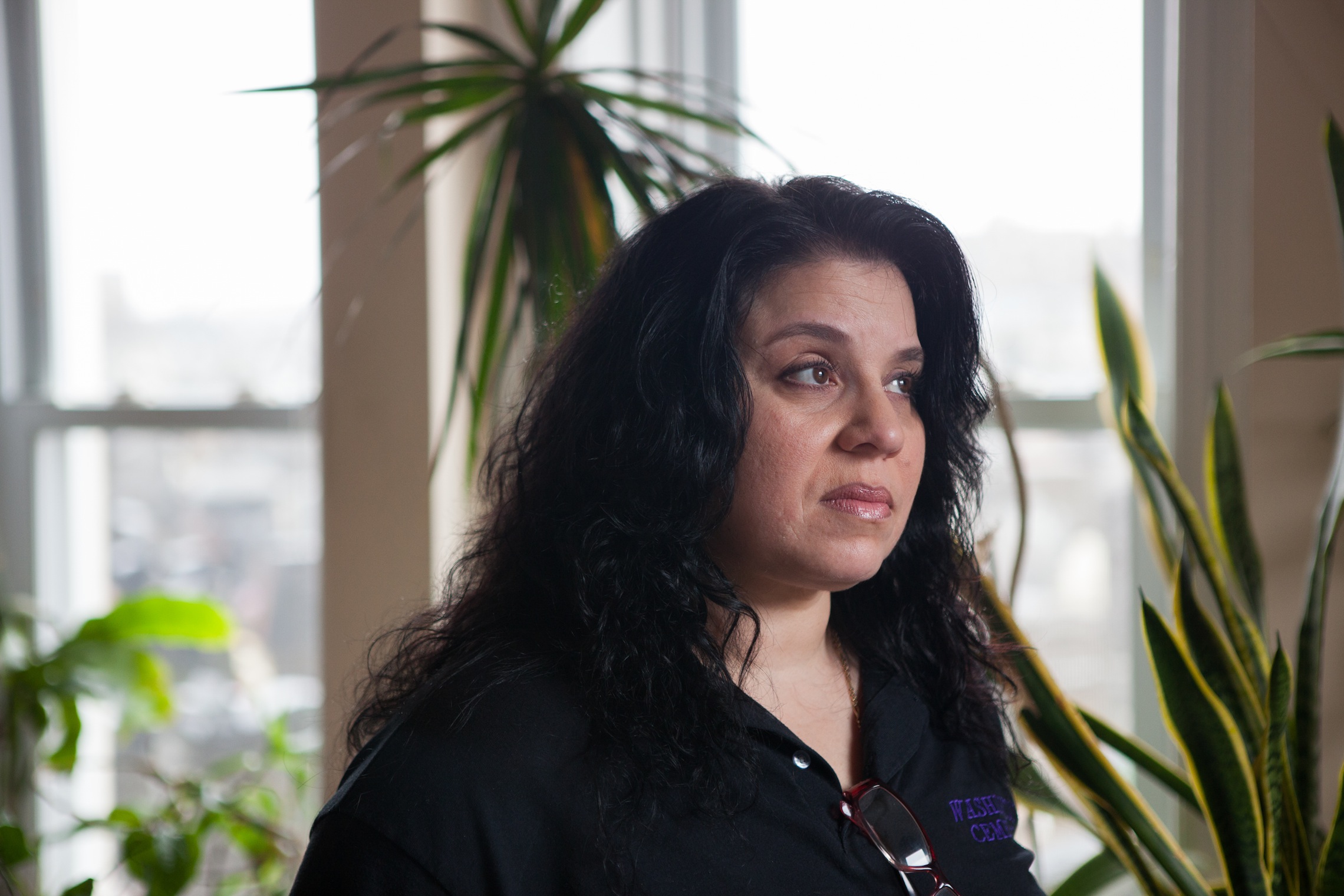
Washington Cemetery provides visual evidence of a cultural conflict. But it’s one that fades with each new generation. The cemetery reached capacity through the burial of a specific group: elderly, first-generation Soviet immigrants. Their children — many of whom were born in Brooklyn — are largely absent from the cemetery.
On a sunny Sunday in late March, an elderly man using a cane ambled out of Washington’s main gates. He was visiting his mother’s grave. He had emigrated with her from Ukraine decades earlier. Did he plan to be buried in Washington someday? “No, no,” he said. “It’s only for the older generation.”
“Once you’ve got a large group of immigrants, in this case, this big Russian bubble-slash-ghetto, or whatever you call it, there’s a tendency to retain those cultural differences. And the cemetery is part of that,” Petlakh says. “It’s a symbol of that cultural difference. The next generation will not have it.”
The increasing demand for Russian burials posed another problem for the Tarantinos. The new immigrants did not belong to any of the old burial societies, whose plots already occupied 80 percent of the cemetery’s land. Though the Tarantinos quickly sold what they legally could to Russian immigrants — plots on the outer edges of the cemetery and in front of the main building — they couldn’t simply sell off the society plots. Anyone who wants to be buried in a society plot must belong to the society, and the society administrator must issue an official burial permit to the cemetery. So where could the Russians be buried?
Making matters more complicated, the burial societies themselves started to go extinct around the same time. First-generation society members died, and their children moved away. Many societies still owned hundreds of burial permits for empty graves in Jewish cemeteries. The society administrators, who controlled the burial permits, often left their children reluctantly in control of them when they died.
When years passed and no one was calling to claim the empty graves, these children had two legal options. They could return the society’s permits and files to the state’s Liquidation Bureau, which has taken up the responsibilities of hundreds of defunct burial societies in the past few years, or they could sell the graves back to the cemetery. The law, however, requires that societies sell the plots back to the cemeteries at the original purchase price, plus 4 percent each year — which makes the price still significantly lower than the current market price for graves.
“Say a society bought [the plots] in 1910 for five bucks,” Fishman says. “Five bucks times 4 percent is what? Not much. Throw in another 80 or 90 years, you might get a hundred bucks.”
Starting in the 1980s, many society administrators began selling their graves illegally. They sometimes do it independently, hawking individual graves through Russian-language newspaper classifieds and Craigslist. More often, they sell the society plot wholesale to a funeral home director, who takes on the task of acting as the “society administrator.” The funeral home then sells off the society’s graves.
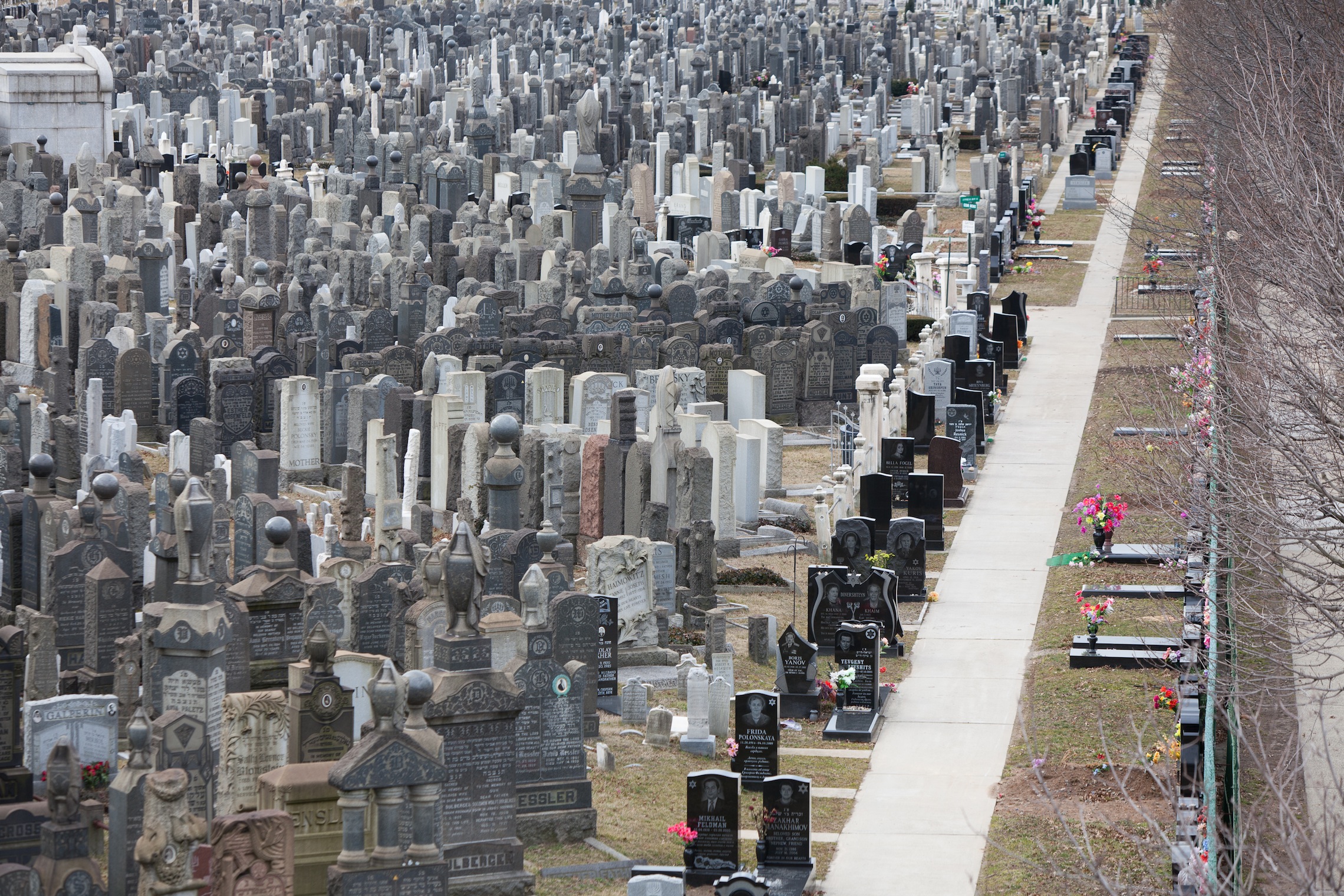
Selling graves in this way is a misdemeanor under the state’s not-for-profit code. Each grave sold is punishable for a fine up to $500 and a six-month jail term. A few years ago, an elderly man named Saul Berman called Fishman and admitted selling graves to I.J. Morris, a funeral home in the Flatlands, in the eighties. He was moving to Florida, and needed someone to take care of the burial society. In 1988, the state charged I.J. Morris with illegally trading 170 burial plots, worth $70,000. Since then, though, the state hasn’t prosecuted the illegal sale of graves. (When I called I.J. Morris, a representative told me that they currently had no graves for sale in Washington Cemetery: “I really don’t want to talk about Washington, so I can’t help you.”)
The black market’s effect on Washington Cemetery looks something like this: a former Muscovite, who died in the 1990s, is buried in a society plot that, in the early 1900s, was explicitly reserved for first-generation Romanian immigrants.
“I didn’t think Jews from Moscow are Romanians,” Fishman said to the administrator of the Romanian society.
“Well, they could have been,” the administrator replied.
“It’s against the law for them to sell graves,” Dominick says. “And they’ve been doing it. And when we notice, we call [the state]. If the society’s in Manhattan, and the person lives in Brighton Beach. Do they belong to the society? I don’t think so.”
Most tri-state Jewish cemeteries also contend with the black market. But because of Washington’s density of society plots and its current popularity with Soviet émigrés, the practice is more clearly visible than at any other cemetery. All you have to do is look at the headstones.
“There’s many that do it — let’s put it that way,” Marisa said. “It’s just our job to alert the state. It’s not our job to act on it, because once we get a society permit, we can bury. It’s up to them [the state] to regulate and go after who’s selling.”
Fishman thinks the cemeteries should sue the corrupt administrators. If most of the society administrators had chosen to sell their plots back to the cemetery, Washington could then have resold those graves at market price. And now, if the Tarantinos could sell the 300 graves in society plots that remain empty, they’d generate enough revenue to run for a year. Instead, the money from each illegal transaction goes straight to the administrator or funeral home rather than to the cemetery. Fishman estimates that each time a grave is sold on the black market, Washington Cemetery loses about $15,000 in potential revenue. But one big lawsuit, he says, “and the rest of them will run like rats.”
Burying in illegally sold society plots provides some revenue for Washington, though. The administrators and funeral home directors pay the cemetery a $1,200 interment fee for each person buried there. This interment fee is now the cemetery’s primary source of revenue. Without the black market, the cemetery would be in even worse shape, restricted from burying anyone at all in the society plots that were locked up a century ago.
To a certain extent, all New York City cemeteries are facing a land shortage. In February, former city mayor Ed Koch was buried in the nondenominational cemetery of Trinity Church in Washington Heights. Trinity’s cemetery is the only one in Manhattan accepting new burials, and in 2008, Koch paid $20,000 for his plot.
Washington is not the first New York City cemetery to fill. But most of the city’s filled cemeteries are affiliated with a church or congregation that can support upkeep and maintenance after its last burial. The New York Marble Cemetery, in the East Village, is one exception. It was the city’s first non-sectarian burial ground, and its last burial was in 1937. In 1969, it was designated a New York City landmark, but the city doesn’t provide financial support to landmarked sites. The cemetery, supported by volunteers and donations, is only open to the public about ten days a year.
Washington is not connected to a congregation and is not designated as a landmark. It still operates privately, employing nine full-time employees, six full-time gravediggers, and about ten additional seasonal workers. It is open to the public six days a week. (It’s closed on Friday evenings and Saturdays, in observance of the Jewish Sabbath.) The Tarantinos see expansion as the only way to continue operating as a privately owned, maintained cemetery open to the public.
In late 2010, a single-family house on Bay Parkway went up for sale. Dominick and Marisa offered to purchase the land, which would have given them space for about 700 graves. But in order to expand, they needed the approval of the city council. A flurry of media attention descended upon on the cemetery and its neighbors, who weren’t keen on the idea.
“Right now, I have a view of a nice house with a lawn,” a 33-year-old firefighter told the Daily News at the time. “I don’t want to see more of that,” he said, pointing down the street toward the cemetery. David Greenfield, the city councilman for the area, blocked the Tarantinos’ proposal.
“People don’t understand that when we say we need land, and that we’re not that financially set, that 70 to 80 percent of our land was purchased by societies for minimal funds,” Marisa says.
Dominick and the foremen continued to go out into the grounds, searching for extra burial space. They closed the remaining roadways, converting them to graves and walkways and establishing the cemetery as walk-through only. (At nearby Green-Wood Cemetery, visitors are given a map and can drive through its winding paths.)
Washington’s now looking into purchasing a small, struggling Methodist church cemetery in Staten Island called Asbury Cemetery. If the purchase goes through, it will add about an acre of land. (The Tarantinos are still in negotiations with the cemetery and would not comment.)
“Is it ideal? No, it’s not ideal,” Fishman, who arranged the initial discussions, said. “But they can clear this acre of land and clean up that other part and make it look good. It would be a non-sectarian cemetery, but they would have a Russian section. It’s a stopgap.”
In a worst-case scenario, Washington Cemetery would be unable to secure any new land and would finally finish burying people in plots sold long ago. The cemetery would run solely off investments. Since the state started regulating cemeteries in 1949, long after most of the cemetery was sold to societies, 10 percent of the sale from each grave has been deposited into a maintenance fund, which generates about $1 million a year. Fishman estimates that’s just under what the Tarantinos need to cover their yearly costs. The Tarantinos would have to lay off cemetery staff and hire contract workers to maintain the grounds.
“The upkeep — there’s no way we’re going to be able to keep it the way it is,” Marisa said. “Maybe we’ll have somebody come in and do one cleaning a year, because that’s what we’ll be able to afford.”
Though it’s unlikely that a developer could buy the land and turn it into a shopping mall or athletic complex — he’d have to get a judge to approve 100,000 disinterments — the place could fall into disrepair, with overgrown grass and impassable walkways. Dominick and Marisa talk about the potential for “going back” — back to the way it was when Dominick first came in in 1987, when ivy grew over nearly every headstone.
“You had to see it, when I came in,” Dominick said. “Whew.”
For the Russian immigrants who visit their relatives weekly, this would undoubtedly be an emotional blow. But three or four generations from now, the names and faces of Washington Cemetery may be just that — names and faces. Like the relatives of the first wave of Jewish immigrants, they may move to Florida and rarely visit their great-great-grandfather’s grave.
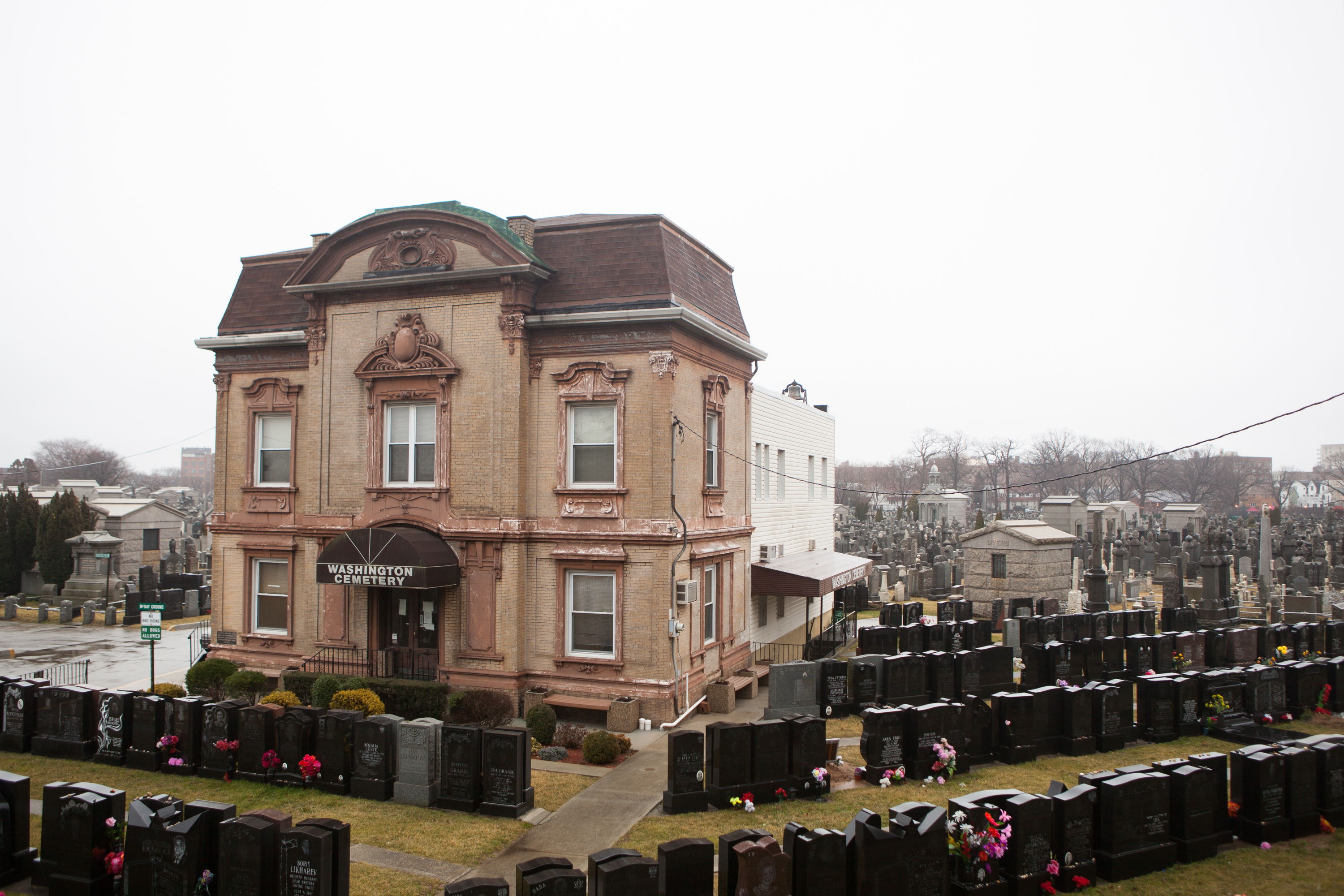
And if cemeteries are for the living, not the dead, as the saying goes, then, 20 years from now, for whom? Now and then, the Tarantinos get calls from Jewish genealogists looking to piece together family histories from Washington’s headstones. For family trees, cemeteries are crucial. But many of Washington’s stones are already photographed and catalogued in online Jewish burial registers, allowing Floridians and Manhattanites alike the chance to encounter their ancestry without setting foot on the F train.
Fishman, though, thinks that in this worst-case scenario, the New York Jewish community would step in and try to salvage the cemetery from ruin. Washington Cemetery is a time capsule: the two distinct groups of people buried in the cemetery don’t have much in common, but they are both first-generation American Jews.
“A lot of Jewish cemeteries in Europe were destroyed by the Nazis,” he says. “The community would have to deal with everything going to seed, so to speak. I don’t think they’re going to let that happen.”
One could argue that Washington demands preservation purely for its unique appearance: the Addams Family-esque main building, the gray obelisks of the early 20th century, the photo-etched black slabs of the late. It is an art history student’s dream and a film student’s perfect backdrop.
Maybe it’s much simpler. Maybe Washington Cemetery’s story is the story of every New York institution: a struggle to survive in a place biased toward failure. It’s a story told over and over again, when every historic shopfront is replaced by a Jamba Juice. It’s made New York famous: fight or flight. Usually, a family is behind the scenes, doing the fighting for years, long before a “for sale” sign goes up.